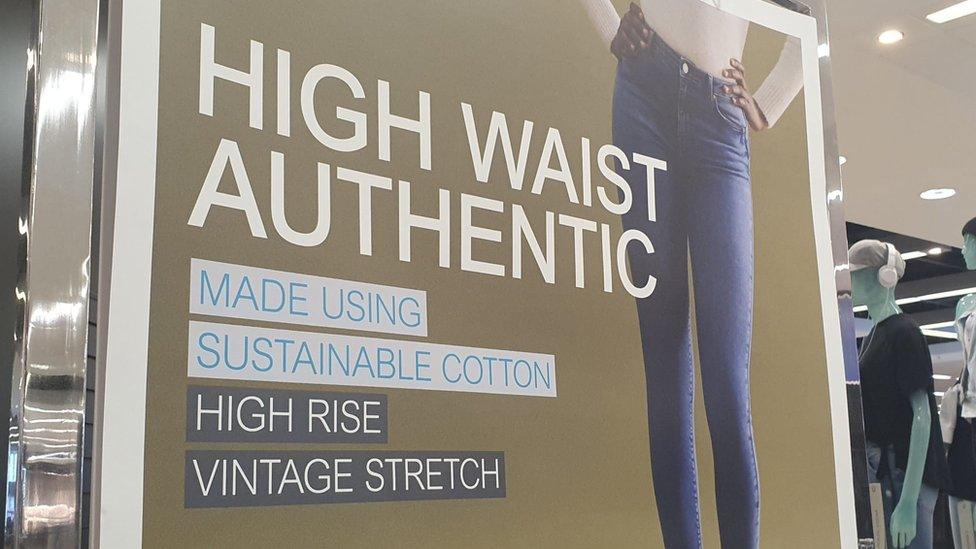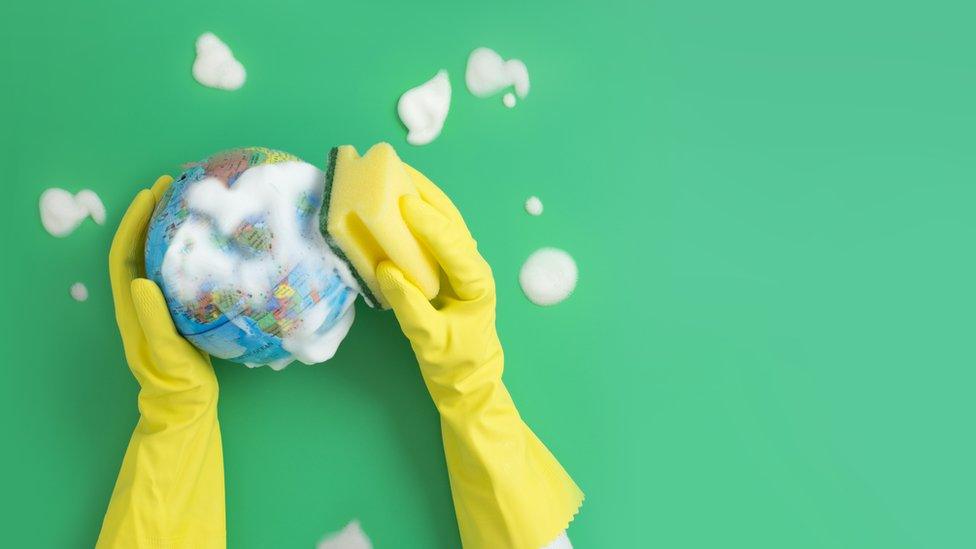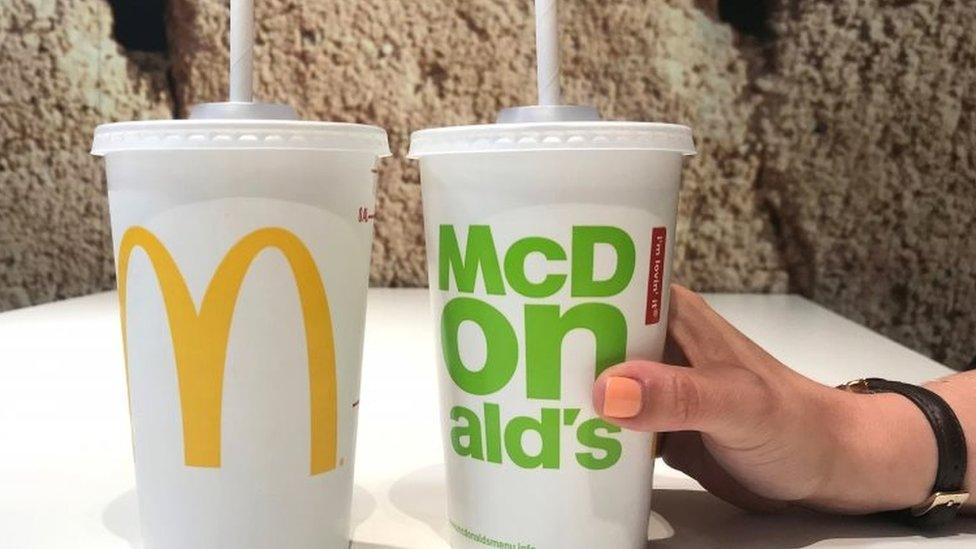What is greenwashing and how can you spot it?
- Published
- comments
COP26: What is greenwashing and what is being done about it?
As climate change has become a big topic around the world, shops and businesses want to show us that they think about it too.
That's why when we walk into shops or go online you might see lots of signs about things being 'eco-friendly', 'organic' or 'sustainable'.
It's great to know that companies are trying to be more environmentally friendly but unfortunately sometimes these signs and slogans aren't always truthful, and they can be used to hide a bigger problem with the way some businesses are run.
While these labels might be true in some cases, sometimes they are deliberately not telling the full story to try and trick customers into thinking they are making an eco-friendly choice.
What is greenwashing?
Greenwashing is a type of marketing. It is a way to make products more appealing to customers who care about the environment.
When companies do things that are harmful to the environment while saying they care about climate change, this is called 'greenwashing'.
The International Consumer Protection Enforcement Network recently analysed 500 websites and found that up to 40% of environmentally friendly claims might be misleading customers.
This means that greenwashing is a common issue, but how do you spot it in the first place?
If you cannot see the interactive activity on this page, click here.
What does greenwashing look like?
You might see lots of examples of greenwashing when you're out shopping on the high street or online, but it can be hard to spot.
Here are a few examples of what greenwashing could look like:
A fashion brand promoting clothes that are made of a 'sustainable' fabric, even if the rest of their clothing line is damaging to the environment.
Ingredients in a product being described as 'natural' or 'organic', when only some of the ingredients can be described as 'natural' or 'organic'.
Offering to carbon offset their products, without committing to any big changes immediately.
Packaging that is coloured green or which is decorated with flowers and plants may make it look less harmful than it is.
Having an eco-friendly version of their product, but not making all their products eco-friendly.

Advertising some products as sustainable or environmentally friendly, when the company does lots of harm to the environment in other ways, can be described as greenwashing
It can be really hard to separate fact from fiction when it comes to greenwashing.
Unfortunately, there's no simple way to identify if something really is sustainable or eco-friendly without doing some background research on the company selling the product.
But there are some signs that you can look out for2, like government approved certifications which mean the company has to stick by certain rules and principles.
In 2018, McDonalds announced that they were going to get rid of single-use plastic straws in their restaurants, and offer paper straws instead.
However they got accused of greenwashing, when it was revealed the straws weren't actually recyclable in 2019!

Why is it a problem?
When greenwashing happens, a person might buy a product or do an activity thinking they're doing something positive for the environment when actually they're not.
And in some cases it could be damaging the environment more without the public realising.
Sometimes this can be done unintentionally - the company might be focusing on one issue that its helping but not looking at the bigger picture and weighing up the harm it might be doing to the environment at the same time.
But sometimes it can be deliberate - companies making their advertising or product names suggest that they're helping the environment even though they're not.
And further to this, it can create distrust in a company.
Trust in green claims is fragile and, unless brands provide the right information to consumers in the right way, there's a risk that consumers will give up. That's bad for green business, bad for consumers and bad for the planet.

Greta Thunberg has criticised the fashion industry for greenwashing practices
What are people saying about it?
Campaigners like Greta Thunberg have talked about their anger when companies greenwash.
In the past, Greta spoke about how angry she was at the fashion industry.
She said on social media that many within the fashion industry make it look like they are helping to the environment and taking responsibility and making a lot of effort to show and tell people this when it's not actually the case.
Many make it look as if the fashion industry is starting to take responsibility, spending fantasy amounts on campaigns portraying themselves as "sustainable", "ethical", "green", "climate neutral" or "fair". But let's be clear: This is almost never anything but pure greenwash.

What can I do to avoid greenwashing?
There are lots of things you can do to avoid greenwashing.
The number one way to spot whether something is as environmentally friendly as it says it is, is to look out for certifications.
Here is a list of some green certifications that the UK recognises:
Leaping Bunny - which means that the product has not been tested on animals.
B Corp - means that a business is legally required to do beneficial things for the environment and the people who help create their products.
Carbon Trust - meets a certain standard of carbon emission reduction, meaning the product is trying to minimise its carbon impact.
Fairtrade - the product has been made by people who received a fair wage for their work.
Forest Stewardship Council (FSC) - the product is made using sustainable or responsibly managed wood sources.
These are just a few of the certifications that are used on products, there are lots more recognised in the UK.
But be careful, as sometimes companies use un-certified labels to make their products look more environmentally friendly than they are!
If in doubt, do some research and find out more about what the facts are behind the label.
How to be fashionable without harming the planet
How has the government responded to greenwashing?
The Competition and Markets Authority, which works to help make business practices fairer in the UK, wants to stop companies from greenwashing - whether intentionally or unintentionally.
In September 2021, they published the Green Claims Code, which encourages companies to check their claims against a set of criteria.
This includes making sure the claim is truthful, substantiated (meaning they must have proof it is accurate) and does not exaggerate the positive environmental impact.
If a business does not follow these rules, it is breaking consumer law, and could be brought to court.
Businesses have until next year to make sure their eco-friendly claims are fair and accurate.
- Published6 August 2019

- Published9 April 2021

- Published10 August 2021

- Attribution
- Published24 June 2021

